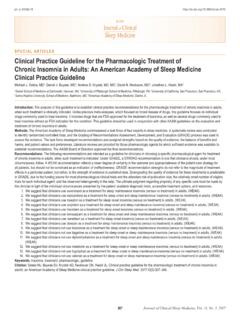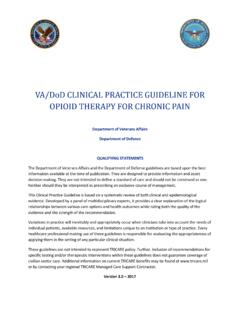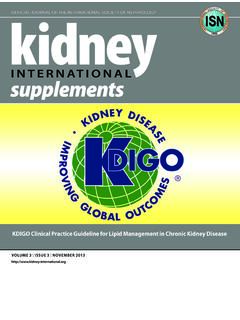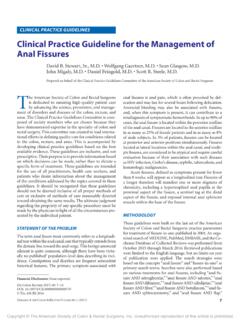Transcription of Clinical practice guideline: management of acute pancreatitis
1 128 J can chir, Vol. 59, No 2, avril 2016 2016 8872147 Canada REVUEC linical practice guideline: management of acute pancreatitisThere has been an increase in the incidence of acute pancreatitis reported worldwide. Despite improvements in access to care, imaging and interventional techniques, acute pancreatitis continues to be associated with significant morbidity and mortality. Despite the availability of Clinical practice guidelines for the management of acute pancreatitis , recent studies auditing the Clinical management of the condition have shown important areas of noncompliance with evidence-based recommendations. This underscores the importance of creating understandable and implementable recommendations for the diagnosis and management of acute pancreatitis .
2 The purpose of the present guideline is to provide evidence-based recommendations for the management of both mild and severe acute pancreatitis as well as the management of complications of acute pancreatitis and of gall stone induced hausse de l incidence de pancr atite aigu a t constat e l chelle mondiale. Malgr l am lioration de l acc s aux soins et aux techniques d imagerie et d intervention, la pancr atite aigu est toujours associ e une morbidit et une mortalit importantes. Bien qu il existe des guides de pratique clinique pour la prise en charge de la pancr atite aigu , des tudes r centes sur la v rification de la prise en charge clinique de cette affec-tion r v lent des lacunes importantes dans la conformit aux recommandations fond es sur des donn es probantes.
3 Ces r sultats mettent en relief l importance de formuler des recommandations compr hensibles et applicables pour le diagnostic et la prise en charge de la pancr atite aigu . La pr sente ligne directrice vise fournir des recommandations fond es sur des donn es probantes pour la prise en charge de la pancr atite aigu , qu elle soit b nigne ou grave, ainsi que de ses complications et de celles de la pancr atite caus e par un calcul pancreatitis can range from a mild, self-limiting disease that requires no more than supportive measures to severe disease with life-threatening complications. The most common causes of acute pan crea-titis are gallstones and binge alcohol There has been an increase in the incidence of acute pancreatitis reported worldwide.
4 Despite improve-ments in access to care, imaging and interventional techniques, acute pancreati-tis continues to be associated with significant morbidity and systematic review of Clinical practice guidelines for the management of acute pancreatitis revealed 14 guidelines published between 2004 and 2008 Although these guidelines have significant overlap in their recommenda-tions for diagnosing and managing acute pancreatitis , there is disagreement in some aspects of both the timing and types of interventions that should be used for both mild and severe acute pancreatitis . The availability of new imaging modalities and noninvasive therapies has also changed Clinical practice . Finally, despite the availability of guidelines , recent studies auditing Clinical manage-ment of acute pancreatitis have shown important areas of noncompliance with evidence-based 9 This underscores the importance of creat-ing understandable and implementable recommendations for the diagnosis and management of acute pancreatitis and emphasizes the need for regular audits of Clinical practice within a given hospital to ensure purpose of the present guideline is to provide evidence-based rec-ommendations for the management of both mild and severe acute pancreatitis as well as the management of complications of acute pancreatitis and of gall stone induced A.
5 Greenberg, MD Jonathan Hsu, MD Mohammad Bawazeer, MD John Marshall, MD Jan O. Friedrich, MD Avery Nathens, MD Natalie Coburn, MD Gary R. May, MD Emily Pearsall, MSc Robin S. McLeod, MDPresented in part at the Canadian Surgery Forum, Sept. 21, 2014, Vancouver, for publication Dec. 7, 2015 Correspondence to: R. McLeod Rm 1612, Cancer Care Ontario 620 University Ave. Toronto ON M5G 2L7 Can J Surg, Vol. 59, No. 2, April 2016 129 MethodologyThe guideline was developed under the auspices of the Best practice in General Surgery group at the University of Toronto. Best practice in General Surgery is a quality initiative aimed to provide standardized evidence-based care to all general surgery patients treated at the Uni-versity of Toronto adult teaching hospitals.
6 A working group consisting of general surgeons, critical care inten-sivists and a gastroenterologist led the development of these recommendations. The working group established the research questions, the analytical framework and clinically relevant outcomes for the guideline. The rec-ommendations pertain to patients with a new presenta-tion of suspected acute pancreatitis . Primary outcomes are complications, both infectious and noninfectious; mortality; length of hospital stay; and readmissions asso-ciated with acute pancreatitis . Definitions of key terms were based on the 2012 Atlanta Classification of acute Pancreatitis10 (Box 1).Initially, we performed a scoping review to identify clin ical practice guidelines related to the management of acute pancreatitis .
7 We then searched Medline for guidelines published between 2002 and 2014 using the Medical Subject Headings pancreatitis and Clinical practice guideline. This search identified 14 guide-lines published between 2008 and 2014. A 2010 sys-tematic review of acute pancreatitis Clinical practice guidelines that included all of the most recent guide-lines was electronic search of Medline was performed using the Medical Subject Headings pancreatitis , acute necrotizing pancreatitis , alcoholic pancrea-titis, and practice guidelines to update the systematic review. The results were limited to articles published in English between January 2007 and January 2014. The references of relevant guidelines were reviewed.
8 Up-to-date articles on acute pancreatitis diagnosis and man-agement were also reviewed for their references11 (as of January 2014).The working group developed the guideline recommen-dations based on evidence as well as consensus. Then the guideline recommendations were circulated to all general surgeons, gastroenterologists and critical care intensivists at the University of Toronto for recoMMendations Table 1 summarizes the guideline recommendations and Diagnosis of acute A serum lipase test should be performed in all patients with a suspected diagnosis of acute pan-creatitis. A 3-fold elevation of serum lipase from the upper limit of normal is required to make the diag-nosis of acute Ultrasonography should be performed in all patients at baseline to evaluate the biliary tract and in par-ticular to determine if the patient has gallstones and/or a stone in the common bile duct (CBD).
9 Magnetic resonance cholangiopancreatography (MRCP) is recommended only in patients in whom there is elevation of liver enzymes and in whom the CBD is either not visualized adequately or is found to be normal on Computed tomography (CT) should be performed selectively when 1) a patient presents with substan-tial abdominal pain and a broad differential diagno-sis that includes acute pancreatitis , or 2) in patients with suspected local complications of acute pan-crea titis ( , peritonitis, signs of shock, suggestive ultrasound findings). Computed tomography for the assessment of local complications is most useful 48 72 hours after the onset of symptoms rather than at the time of admission.
10 Unless contraindi-cated ( , renal dysfunction), intravenous contrast should be given in order to assess for pancreatic necrosis once patients are adequately fluid resusci-tated and normovolemia is 1. Definitions of key terms (based on the 2012 Atlanta Classification of acute Pancreatitis10) Diagnosis of acute pancreatitis (2 of the following) Abdominal pain ( acute onset of a persistent, severe, epigastric pain often radiating to the back) Serum lipase activity (or amylase) at least 3 times greater than the upper limit of normal Characteristic findings of acute pancreatitis on computed tomography or magnetic resonance imagingMild acute pancreatitis No organ failure, local or systemic complicationsModerately severe acute pancreatitis Organ failure that resolves within 48 h and/or Local or systemic complications without persistent organ failureSevere acute pancreatitis Persistent organ failure > 48 hInterstitial edematous acute pancreatitis acute inflammation of the pancreatic parenchyma and peri-pancreatic tissues.










